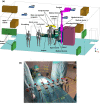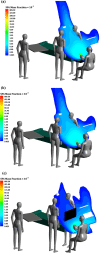Reducing the risk of viral contamination during the coronavirus pandemic by using a protective curtain in the operating room
- PMID: 35933393
- PMCID: PMC9356414
- DOI: 10.1186/s13037-022-00332-x
Reducing the risk of viral contamination during the coronavirus pandemic by using a protective curtain in the operating room
Abstract
Background: Airborne transmission diseases can transfer long and short distances via sneezing, coughing, and breathing. These airborne repertory particles can convert to aerosol particles and travel with airflow. During the Coronavirus disease 2019 (COVID-19) pandemic, many surgeries have been delayed, increasing the demand for establishing a clean environment for both patient and surgical team in the operating room.
Methods: This study aims to investigate the hypothesis of implementing a protective curtain to reduce the transmission of infectious contamination in the surgical microenvironment of an operating room. In this regard, the spread of an airborne transmission disease from the patient was evaluated, consequently, the exposure level of the surgical team. In the first part of this study, a mock surgical experiment was established in the operating room of an academic medical center in Norway. In the second part, the computational fluid dynamic technique was performed to investigate the spread of airborne infectious diseases. Furthermore, the field measurement was used to validate the numerical model and guarantee the accuracy of the applied numerical models.
Results: The results showed that the airborne infectious agents reached the breathing zone of the surgeons. However, using a protective curtain to separate the microenvironment between the head and lower body of the patient resulted in a 75% reduction in the spread of the virus to the breathing zone of the surgeons. The experimental results showed a surface temperature of 40 ˚C, which was about a 20 ˚C increase in temperature, at the wound area using a high intensity of the LED surgical lamps. Consequently, this temperature increase can raise the patient's thermal injury risk.
Conclusion: The novel method of using a protective curtain can increase the safety of the surgical team during the surgery with a COVID-19 patient in the operating room.
Keywords: Airborne infectious disease; COVID-19; Computational fluid dynamics; Operating room; Protective curtain; Thermal injury.
© 2022. The Author(s).
Conflict of interest statement
The authors declare to have no competing interests.
Figures





Similar articles
-
Do surgeons and surgical facilities disturb the clean air distribution close to a surgical patient in an orthopedic operating room with laminar airflow?Am J Infect Control. 2018 Oct;46(10):1115-1122. doi: 10.1016/j.ajic.2018.03.019. Epub 2018 May 4. Am J Infect Control. 2018. PMID: 29735253
-
Assessment of airborne transmission from coughing processes with thermal plume adjacent to body and radiators on effectiveness of social distancing.Environ Sci Pollut Res Int. 2022 Sep;29(44):66808-66840. doi: 10.1007/s11356-022-18713-1. Epub 2022 May 4. Environ Sci Pollut Res Int. 2022. PMID: 35508854
-
Ventilation-Based Strategy to Manage Intraoperative Aerosol Viral Transmission in the Era of SARS-CoV-2.Life (Basel). 2024 Feb 28;14(3):313. doi: 10.3390/life14030313. Life (Basel). 2024. PMID: 38541639 Free PMC article.
-
Airborne transmission of severe acute respiratory syndrome coronavirus-2 to healthcare workers: a narrative review.Anaesthesia. 2020 Aug;75(8):1086-1095. doi: 10.1111/anae.15093. Epub 2020 May 8. Anaesthesia. 2020. PMID: 32311771 Free PMC article. Review.
-
How human thermal plume influences near-human transport of respiratory droplets and airborne particles: a review.Environ Chem Lett. 2021;19(3):1971-1982. doi: 10.1007/s10311-020-01178-4. Epub 2021 Jan 21. Environ Chem Lett. 2021. PMID: 33495695 Free PMC article. Review.
References
-
- Naseri A, Emdad H, Mehrabi S, Sadrizadeh S, Abouali O. Inhalability of micro-particles through the human nose breathing at high free-stream airflow velocities. Build Environ. 2020;179:106948. doi: 10.1016/j.buildenv.2020.106948. - DOI
-
- Hinds WC. Aerosol Technology : Properties, Behavior, and Measurement of Airborne Particles. 1999. p. 3.
LinkOut - more resources
Full Text Sources

